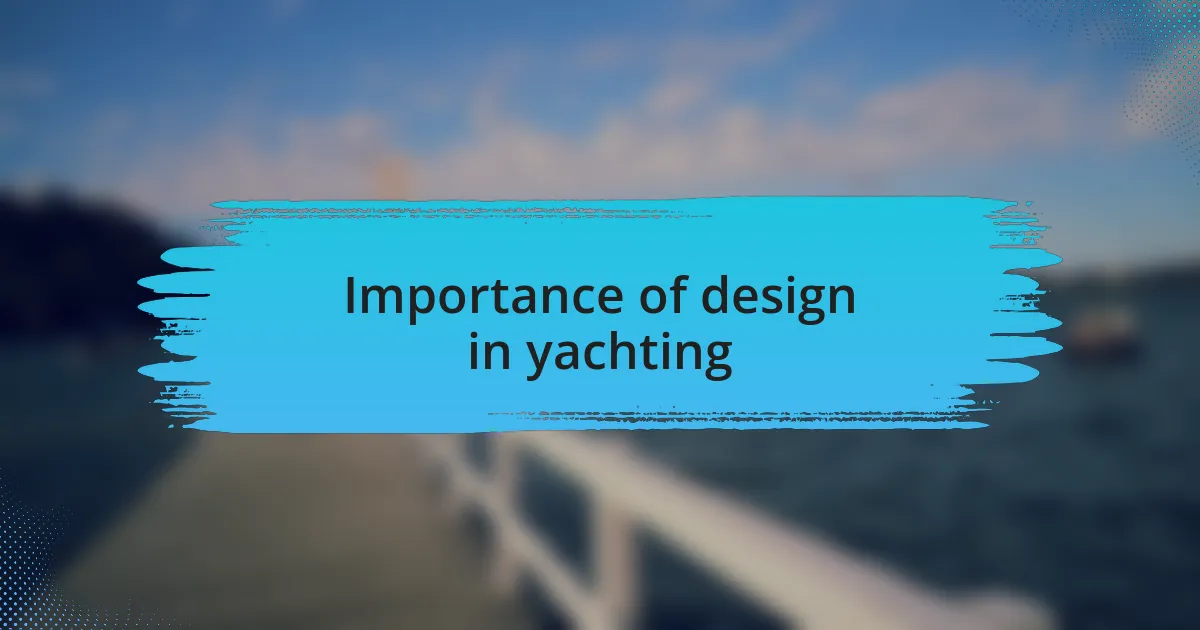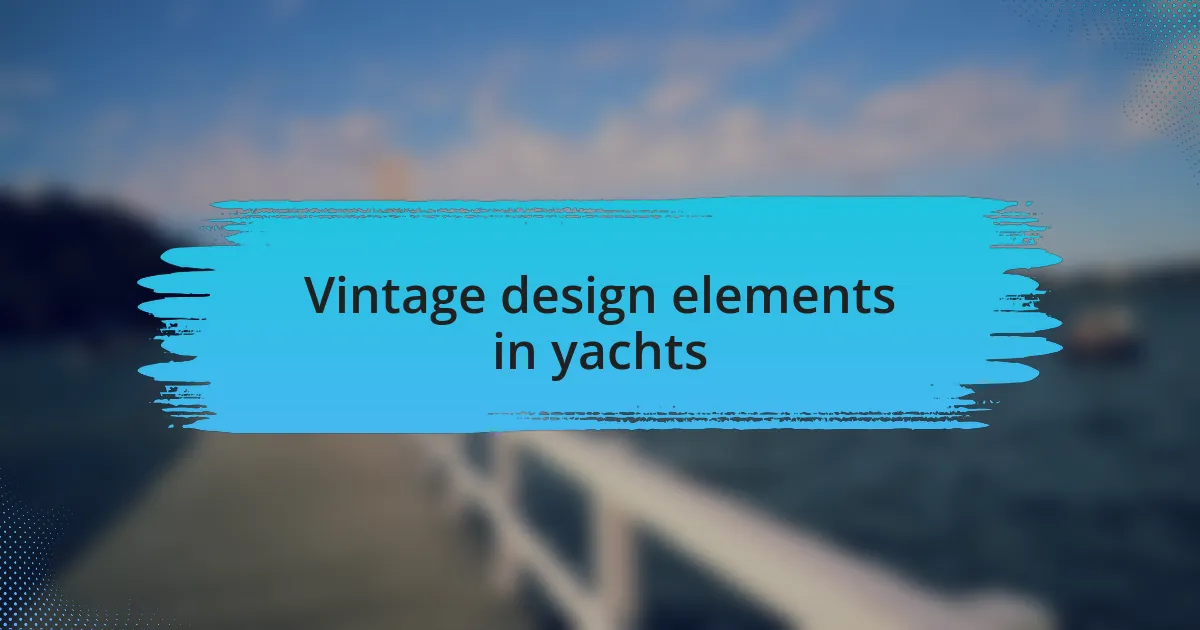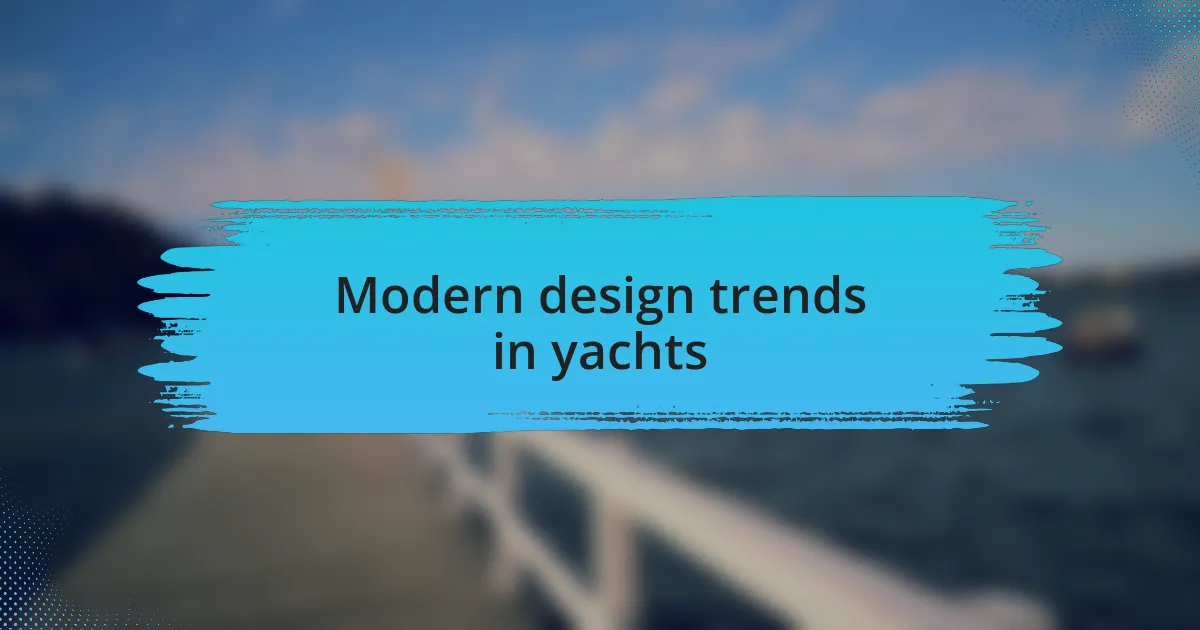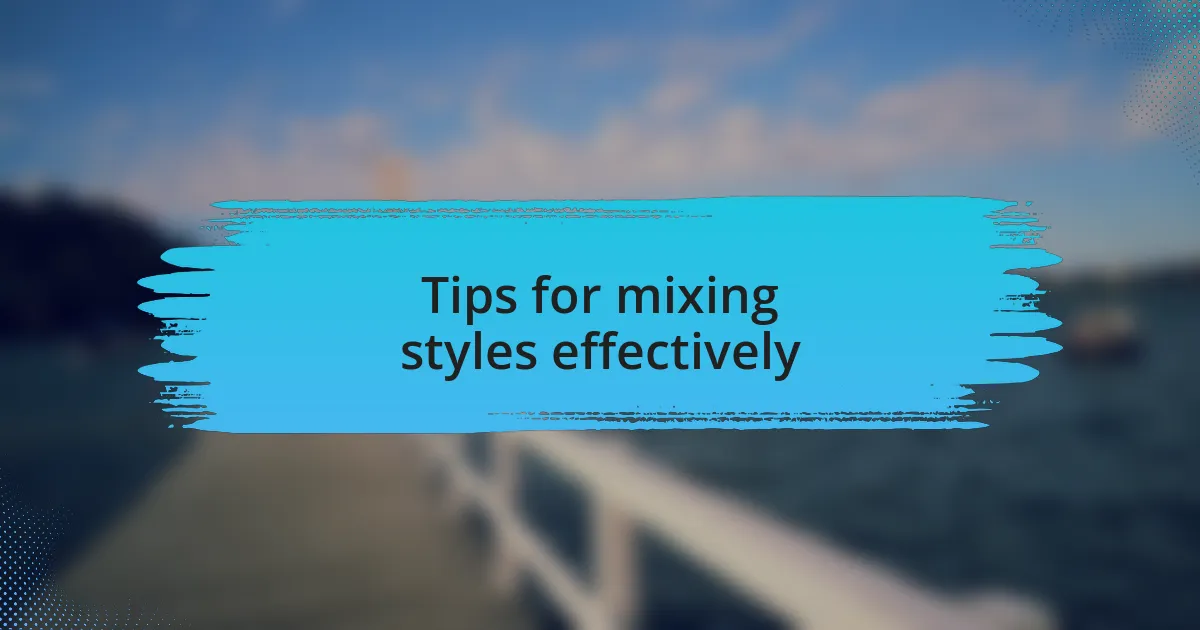Key takeaways:
- Luxury yachts combine advanced engineering with exquisite design, creating personalized floating homes that reflect the owner’s style and values.
- Effective yacht design balances aesthetics and functionality, enhancing both performance and the overall seafaring experience.
- The fusion of vintage and modern elements in yacht design can evoke nostalgia while embracing contemporary innovations and sustainability.
- Mixing styles requires careful attention to proportions, texture, and storytelling, creating a harmonious and inviting atmosphere onboard.

Understanding luxury yachts
Luxury yachts represent the pinnacle of opulence on water, seamlessly blending advanced engineering with exquisite design. I remember stepping onto a beautifully crafted yacht for the first time; the polished wood and gleaming chrome made me feel as if I had entered a floating masterpiece. Doesn’t it pique your curiosity what goes into crafting such a luxurious vessel?
Each luxury yacht tells a story, from its handcrafted interiors to state-of-the-art technology that enhances comfort on the sea. When I think back to my evenings spent aboard, surrounded by fine art and plush furnishings, I realize that luxury in yachting is not just about the lavish amenities but about creating unforgettable experiences. How do you envision your ideal escape on the water?
In understanding luxury yachts, one must appreciate the attention to detail that goes into every element. The delicate balance of aesthetics and functionality reflects not only the owner’s style but also the craftsmanship behind the vessel. I once met a yacht designer who shared how they blend client preferences with innovative solutions; it was enlightening to see how much passion drives the yachting world. Isn’t it fascinating how every yacht is, in its own way, a personalized floating home?

Importance of design in yachting
Design plays a crucial role in yachting, as it directly influences both aesthetics and functionality. I recall a stunning yacht where every curve and finish seemed meticulously chosen to enhance the seafaring experience, making it feel like an extension of the ocean itself. Have you ever wondered how design can transform space, creating an atmosphere that makes time spent onboard truly magical?
The thoughtful design of a yacht affects not just its appearance, but also its performance on the water. For instance, efficient layouts and strategically placed features can optimize space while ensuring smooth sailing. I remember being particularly impressed by a yacht with an innovative deck layout that allowed for seamless movement, perfect for enjoying the sunset without feeling cramped. Isn’t it incredible how design can elevate enjoyment on the open seas?
Moreover, design in yachting serves as a reflection of personal identity and lifestyle. Each yacht I’ve encountered has its unique charm, often mirroring the owner’s personality. I often think about a friend of mine who chose bold colors and modern lines for their yacht, making a statement that perfectly captured their adventurous spirit. How do you feel about the idea that every design choice tells a story about who we are?

Vintage design elements in yachts
When it comes to vintage design elements in yachts, I find that they evoke a sense of nostalgia that’s both captivating and timeless. For instance, the use of rich woods and brass fixtures can transport you back to an era where craftsmanship reigned supreme. I once sailed on a yacht adorned with these classic touches, and it instantly made me feel like I was part of something grand, reminiscent of old seafaring tales.
I also appreciate how vintage elements can blend seamlessly with modern features. Imagine a yacht where traditional leather upholstery meets cutting-edge technology; the contrast creates an inviting yet sophisticated environment. I vividly remember a gathering on a yacht that expertly combined these aesthetics, where guests would toggle between admiring the vintage bar setup and marveling at the latest audio-visual entertainment. It made me wonder, can modern innovations coexist harmoniously with classic designs?
Additionally, vintage nautical maps and retro-inspired lighting can serve not only as décor but as conversation starters. I recall being enchanted by the stories shared over a beautifully framed antique map on a friend’s yacht. It was a reminder that every piece can spark curiosity and connection. Have you ever experienced a moment where a design element prompted a rich discussion about travel and adventure?

Modern design trends in yachts
Modern designs in yachts are characterized by their sleek lines and minimalist aesthetics, creating a sense of openness and freedom on the water. I once stepped aboard a contemporary yacht that featured expansive glass windows, allowing natural light to flood the interior. This design choice made the space feel connected to the sea, almost as if it were part of the ocean itself. Isn’t it astonishing how a single design element can transform our perception of space?
The use of sustainable materials is another rising trend in yacht design. I remember admiring a yacht that was not only stunning in its modern craftsmanship but also constructed from eco-friendly resources. It made me reflect on how luxury can embrace responsibility, creating a harmonious balance between indulgence and environmental consciousness. Doesn’t it feel rewarding when beauty and sustainability go hand in hand?
Additionally, smart technology integration has become a hallmark of modern yacht design. I vividly recall being impressed by a vessel where everything, from lighting to climate control, was automated at the touch of a button. This level of convenience elevates the overall experience, allowing for a lifestyle that feels luxurious and effortless. Have you ever imagined how much easier life can be when everything is just a tap away?

Balancing vintage and modern styles
Finding the right balance between vintage and modern designs in yachts is a dance of aesthetics and emotions. I recall walking through a beautifully designed yacht where vintage mahogany paneling complemented sleek, modern fixtures. The warmth of the wood created an inviting atmosphere, reminding me of classic sailing adventures while the modern elements conjured a sense of luxury and innovation. Isn’t it intriguing how the past can coexist so harmoniously with the present?
Incorporating vintage touches can evoke nostalgia, connecting us to a bygone era of seafaring elegance. I once witnessed how a carefully curated selection of vintage nautical artifacts adorned a yacht, sparking conversations and inviting stories from various journeys. The keys to this balance lie in thoughtfully selecting pieces that resonate with both styles, creating a seamless narrative that enriches the overall aesthetic. Have you ever noticed how a well-placed vintage item can transform an entire space?
Maintaining visual cohesion is crucial when blending these two design worlds. I’ve seen yachts where modern forms merge with antique furnishings in such a way that neither style overshadows the other. This balance encourages a flow, guiding the eye without creating discord. Isn’t it fascinating how design can be both a reflection of our present aspirations and a tribute to the richness of our history?

Personal insights on design integration
Design integration is truly an art form, especially when fusing vintage and modern elements onboard. I remember visiting a yacht where sleek glass tables stood proudly next to a vintage brass telescope. The juxtaposition of these materials sparked my curiosity; the smoothness of the glass highlighted the history embedded in the telescope, inviting me to ponder its past adventures. Have you ever felt that thrill when two distinct eras unite like this?
As I’ve delved into the world of yacht design, I’ve realized that every choice we make speaks volumes. One yacht owner I spoke with lovingly restored a classic chaise lounge and paired it with minimalist lighting fixtures. The interaction between the old and the new defined the space, making it feel both timeless and contemporary. Isn’t it remarkable how such contrasts can evoke layered feelings of comfort and inspiration?
Another insight I’ve gathered is about the role of color in achieving harmony. A yacht with muted, earthy tones can beautifully enhance both vintage woods and contemporary lines. I once saw a yacht that employed a color palette reflective of the sea and sky, uniting disparate design elements into a cohesive whole. Have you thought about the power of color in your own design journeys?

Tips for mixing styles effectively
When it comes to mixing styles effectively, the balance of proportions is key. I remember visiting a stunning yacht where an antique dining table found its match with sleek modern chairs. The striking visual appeal came from the careful sizing—each piece complemented the other while maintaining its unique presence. Have you considered how scale can influence the visual dialogue between vintage and contemporary designs?
Texture plays a crucial role too. There’s a yacht I once admired that featured plush velvets and rough-hewn woods side by side. This textured contrast not only added depth but also created a tactile experience that draws you in. It’s fascinating how a simple touch can evoke such distinct feelings, isn’t it?
Lastly, consider storytelling through your selections. I encountered an owner who curated their yacht with items that each had a personal narrative—like a vintage globe next to modern art. This blend invited guests to explore the stories behind the pieces, making every corner of the yacht unique. How can your selections tell your own story within the design?